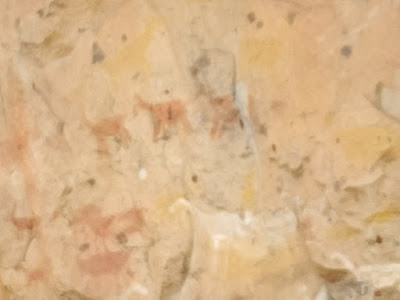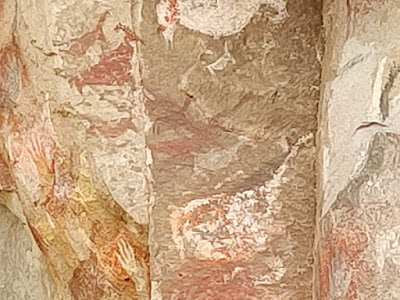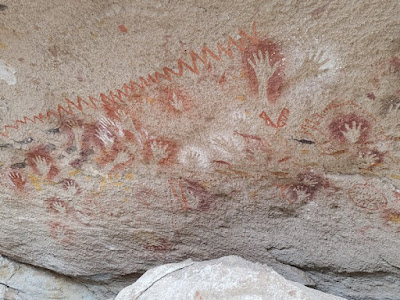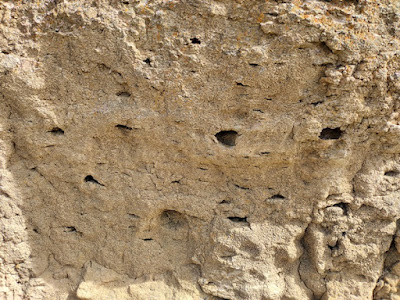We left the free campground and headed off to see the Cueva de las Manos, the Cave of the Hands. It's a UNESCO Cultural Heritage site now and we had to drive about 20 miles of gravel road to reach the tiny visitor center.
The 'negative' painting of thousands of hands on the rock walls and ceilings in and near the caves here have been made over the last 10,000 years or so by many generations of the local inhabitants.
The red, white, and greens of the local hills provided the pigments used to make the paintings on the walls.
Cool canyon rocks near the cave. Hardy folks can hike here for a different approach. Gustavo warned us the hike was grueling and would take at least 9 hours; he showed us where to turn off to drive right up to the visitor center access instead.That funky figure of a man originated from a drawing found here in the Cave. This sign outlines a few of the other figures we'd see painted on the walls.
The view up the valley from the visitor center at Cueva de las Manos.
Steep rock walls loomed above us all along our walk to the cave paintings.
Many layers of the negative hand paintings cover the walls here.
Black, red, orange, green and white colors were used to make the hand paintings.
Figures of birds and animals were painted on the walls, too.
These guanacos were done in a yellow ochre.
These are in black.
The local reddish color was very popular, too. The 400+ meters of painting told a story of hunting and killing the guanaco by a group of hunters.
Layers and layers of hand prints make for interesting viewing.
The location under rock ceilings and along the walls of caves where the sun, wind, and rain don't reach them has preserved thes images for ten thousand years!
They have used carbon dating to determine when these were made--3000-9300 years ago with some thought to be a bit older.
The local deer, the huemul may be the animal pictured here. We saw signs warning us of them along the road, but never saw one. They are now endangered and live only in small pockets in Patagonia.
It's amazing how well preserved these paintings are! And how numerous.
Animals and a rare spiral adorn this wall. Techniques and designs changed over the centuries.
This one includes the full forearm, an unusual print.
A stylized figure that reminds us of the metal man sculpture we saw outside the visitor center.
More pictographs on the stone wall.
Some are so clear still.
Others are fading.
This hand only has three fingers. Another showed six fingers on the hand in a different part of the cave wall complex.
A unique figure on the wall.
Large bird footprints were included here. The three-toed prints are from the nandu, a large rhea bird like a small ostrich. We've seen them as we drive along, but they are too skittish to get close enough to get a picture with my phone.
We wondered how such short people got up to put the prints so high on the walls or ceilings. The guide could only speculate.
Dotted lines appeared as times changed to represent lines of hunters surrounding the animal.
More 'modern' designs include the zigzag motif shown here.
Another spiral, a figure that evolved over time in the drawings.
The drawing like the 'metal man' we saw in town sculptures. This figure has become iconic for the cave.
Quite a mix of symbols and signs here.
On some of the ceiling, they threw up wads of sinew dipped in paint pigment to make dots on the ceiling. Not sure if they were meant to represent stars or not.
Our tour group of twenty as we walk under a big overhang. We all had to wear hard hats and the crumbly rock overhead was why.
An iconic photo of the many hands and symbols and colors here.
Some more stylistic forms on the rock.
The guide thinks the hand with the circles around it may have belonged to someone of very high stature in the group.
Jason in his hard hat.
Karen in her hard hat. We cinched them down good so they didn't blow off our heads on this windy day.
Colorful wall paintings.
One of my favorites.
Our view of the setting sun colors on the mountain across the canyon. We are parked just above the entrance to the visitor center for Cueva de las Manos.
Herds of guanaco were sleeping in the road, out of the wind in this valley until we drove up and scattered them.
Guanaco are very common in Patagonia and we saw hundreds of them as we drove.
Curious but skittish from vehicles, they would bolt and run along the fence lines that line the highway on both sides.
This one is debating whether to try to jump the fence to get away from us. All the ones we saw jump made it over, but many do not. Their back legs get caught and they hang there until they die.
The gate for this road into Canyon Caracol Chico was open as we drove away from the Cave of the Hands, so we took a walk into the canyon for a short way.
Lots of guanaco bones and skeletons were scattered about the rocks. Puma perhaps....
Looking across the river in the canyon. Jason is that dark dot in the center of the shot.
A chimney rock formation near the mouth of the canyon.
The pockmarked wall of crumbly rock. It didn't look very stable.
Jason holding a skull and some bones from a guanaco skeleton.
A closeup of the crumbly rock wall in the canyon.
Looking up a sheer rock wall in the canyon.
Great formations in the rock walls of Canyon Caracol Chico.
A guanaco skull along the walk.
An example of a guanaco who didn't make the fence jump successfully. There were stretches of Route 40 where we couldn't go 100 yards without seeing a guanaco carcass or skeleton hanging from its back legs on the fence. Sad, but apparently it's been happening for many years as they were in all stages of decomposition. They just don't get their back legs up high enough to clear the fence.
Lots of signs along the road warn of the animals that roam the steppe here.




























































No comments:
Post a Comment